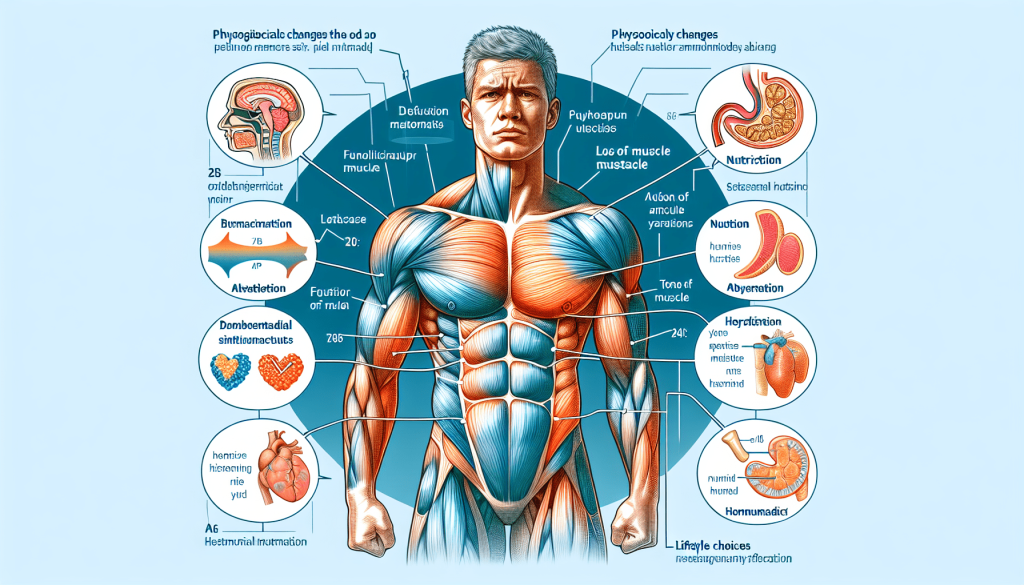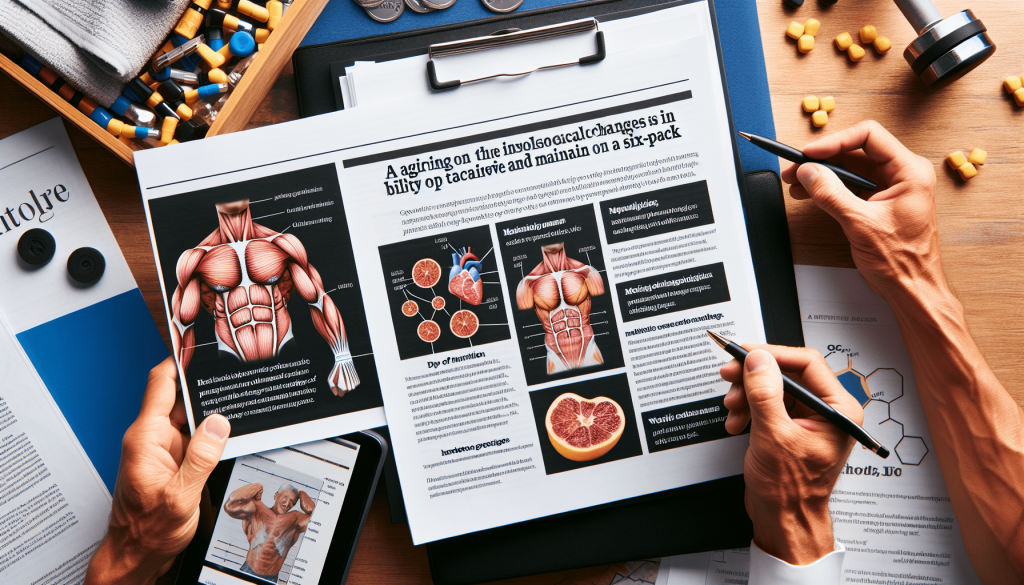As we get older, our bodies go through numerous changes, both internally and externally. One area that seems to be particularly affected by the passage of time is our ability to achieve and maintain a six-pack. We often find ourselves wondering how aging impacts our quest for those coveted abs and strong core muscles. In this article, we’ll delve into the topic, exploring the various ways in which aging can potentially hinder our ability to achieve a chiseled midsection and what steps we can take to overcome these challenges. So, whether you’re in your twenties, thirties, forties, or beyond, this article is here to offer you some insights into the impact of aging on your journey to rock-solid abs.

Changes in metabolism
Slowing of metabolism with age
As you age, your metabolism naturally begins to slow down. This means that your body burns fewer calories at rest, making it more challenging to maintain a low body fat percentage. Metabolism is influenced by various factors, including muscle mass, hormonal levels, and overall activity levels. While genetics play a role in determining your metabolic rate, age also plays a significant role in slowing down your metabolism.
Effect on body fat percentage
With a slowed metabolism, you may notice an increase in body fat percentage as you age. This is because the calories you consume are not being burned as efficiently, leading to weight gain. Your body fat percentage is the proportion of fat to non-fat (muscle, bone, water) components in your body. As your metabolism slows down, it becomes more difficult to maintain a lean physique and achieve visible abdominal muscles.
Hormonal changes
Decreased testosterone levels
Another factor that can impact your ability to get and maintain a six-pack as you age is the decrease in testosterone levels. Testosterone plays a vital role in building and maintaining muscle mass. As you get older, your testosterone levels naturally decline, making it harder to build and preserve muscle.
Impact on muscle mass
With decreased testosterone levels, muscle mass tends to decrease. This loss of muscle mass, referred to as age-related muscle loss or sarcopenia, is a common consequence of aging. Sarcopenia can lead to a decrease in overall strength and muscle definition, including the visible abs that many people strive for.
Loss of muscle mass
Age-related muscle loss
Age-related muscle loss, or sarcopenia, is a condition that affects many individuals as they grow older. It is characterized by a gradual decline in muscle mass and strength. Sarcopenia can have various causes, including hormonal changes, decreased physical activity, and insufficient protein intake. This loss of muscle mass can make it more challenging to achieve and maintain a six-pack, as the underlying muscles are not as strong or well-developed.
Sarcopenia and its effects
Sarcopenia not only affects the appearance of your abdominal muscles but also has broader implications for your overall health and functionality. As muscle mass declines, it can lead to decreased mobility, balance issues, and an increased risk of falls. It is crucial to address sarcopenia through strength training exercises and a protein-rich diet to help maintain muscle mass and support abdominal muscle development.
Increased difficulty in abdominal muscle development
Reduction in muscle fiber size
With aging, there is a natural reduction in muscle fiber size, known as muscle fiber atrophy. This decrease in muscle size can make it more challenging to develop and define abdominal muscles. As muscle fibers shrink, the overall muscle volume decreases, resulting in less visible muscle definition, including the coveted six-pack abs.
Challenges in building and retaining abdominal muscles
In addition to the reduction in muscle fiber size, other factors contribute to the increased difficulty in building and retaining abdominal muscles as you age. These factors include hormonal changes, slower metabolism, and decreased testosterone levels. It becomes crucial to focus on targeted exercises and lifestyle modifications to effectively build and maintain abdominal muscles.

Decline in collagen production
Effects on skin elasticity
Collagen is a protein that provides strength and elasticity to our skin. As we age, there is a decline in collagen production, leading to decreased skin elasticity. The reduced elasticity can affect the appearance of your abdominal muscles. Without sufficient collagen, the skin may not tightly adhere to the underlying muscle, resulting in reduced muscle definition and a less defined six-pack appearance.
Role of collagen in achieving a defined six-pack
Collagen plays a crucial role in achieving a defined six-pack. It helps maintain skin elasticity and tightness, allowing the underlying muscle definition to be more visible. To support collagen production, it is essential to consume a balanced diet rich in protein, vitamin C, and other nutrients that promote collagen synthesis. Additionally, lifestyle habits such as avoiding excessive sun exposure and not smoking can help preserve collagen levels and maintain healthy skin.
Impact of lifestyle factors
Dietary changes and increased difficulty in achieving low body fat
As you age, dietary changes may impact your ability to achieve a low body fat percentage and visible abdominal muscles. Metabolic changes and hormonal fluctuations can make it more challenging to maintain a strict diet and achieve the desired level of leanness. It becomes crucial to focus on a balanced diet that includes lean proteins, whole grains, fruits, vegetables, and healthy fats to support muscle development and manage body fat levels.
Physical activity and its role in maintaining abdominal muscles
Regular physical activity is crucial for maintaining abdominal muscles and overall body composition, especially as you age. Engaging in both cardiovascular exercises and strength training exercises can help preserve muscle mass, increase metabolism, and promote fat loss. By incorporating exercises that target the abdominal muscles, such as planks, crunches, and leg raises, you can strengthen the core and promote the development of a six-pack.

Joint and mobility issues
Effects of aging on joint health
As you age, joint health can be affected by various factors, including wear and tear, decreased cartilage elasticity, and inflammation. Joint issues can limit mobility and make it more challenging to engage in exercises that target the abdominal muscles. However, with proper care, such as stretching, low-impact exercises, and joint support, it is possible to maintain mobility and still work towards achieving a six-pack.
Importance of flexibility for visible abdominal muscles
Flexibility plays a crucial role in achieving visible abdominal muscles. It allows for a greater range of motion during exercises, helping to engage and strengthen the abdominal muscles effectively. Incorporating flexibility exercises, such as yoga or stretching routines, can improve joint mobility and contribute to better muscle definition in the abdominal region.
Importance of overall body composition
Distribution of body fat
When aiming for a six-pack, it is essential to consider your overall body composition, specifically the distribution of body fat. Even with well-developed abdominal muscles, a layer of body fat can hide the muscle definition. Genetics can influence where your body tends to store fat, with the abdominal region being a common area. To achieve a visible six-pack, it may be necessary to focus on reducing overall body fat through a combination of proper nutrition, exercise, and healthy lifestyle choices.
Balance between muscle mass and body fat
Achieving a six-pack is not solely about building abdominal muscles but also about finding a balance between muscle mass and body fat levels. Having a healthy balance between the two is crucial for achieving a defined and sculpted appearance. It is important to remember that everyone’s body is unique, and there is no one-size-fits-all approach. Strive for a balanced lifestyle that includes regular exercise, nutritious eating, and a healthy mindset to support both muscle development and fat loss.

Psychological factors
Motivation and determination
Building and maintaining a six-pack requires not only physical effort but also psychological factors such as motivation and determination. As you age, it is essential to stay motivated and set realistic goals that align with your current abilities and lifestyle. Celebrate progress and understand that achieving visible abdominal muscles takes time and consistency. By maintaining a positive attitude and staying determined, you can overcome the challenges of aging and reach your fitness goals.
Mindset and self-perception
Your mindset and self-perception play a significant role in your ability to get and maintain a six-pack as you age. Embrace your body’s changes and focus on building overall strength and health rather than obsessing over visible abs. Develop a positive body image and prioritize self-care, recognizing that aging is a natural process. By fostering a healthy mindset and embracing your body’s capabilities, you can achieve a sense of satisfaction and confidence in your fitness journey.
Adapting workout routines
Tailoring exercises to accommodate aging body
As you age, it is crucial to adapt your workout routines to accommodate your changing body. This may involve modifying exercises, reducing the intensity, or incorporating more rest days. Listen to your body and be mindful of any limitations or discomfort. Consult with a fitness professional who can guide you in tailoring exercises that are suitable for your specific needs and goals.
Focus on core and functional movements
To maintain abdominal muscles and support overall strength, it is beneficial to focus on core and functional movements. Core exercises, such as planks, Russian twists, and bicycle crunches, target the muscles in the abdominal region. Functional movements, such as squats, deadlifts, and lunges, engage multiple muscle groups, including the core, while mimicking everyday movements. By incorporating these exercises into your routine, you can strengthen your core and enhance overall functionality.
In conclusion, aging does present challenges in achieving and maintaining a six-pack, but with the right approach and mindset, it is still possible to attain strong abdominal muscles and a defined physique. Understanding the impact of aging on metabolism, hormones, muscle mass, collagen production, and joint health can help you adapt your lifestyle and exercise routines accordingly. Remember that overall body composition, psychological factors, and adapting workout routines are equally important in your quest for a six-pack. Stay motivated, embrace the journey, and prioritize your overall health and well-being.






